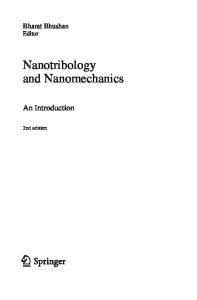Adhesion, Friction, and Wear
- PDF / 911,673 Bytes
- 5 Pages / 604.8 x 806.4 pts Page_size
- 18 Downloads / 345 Views
imilar to a Brinell hardness test. 2. At the beginning of the contact cycle, the asperities interfère in the direction of sliding (Figure 2). Thus during the first half of the contact cycle, frontal ïoading of the asperities occurs (Figure 2b). Particularly if the resulting déformation is plastic (as it will usually be for metals, see Référence 1), the net effect of this contributes to friction, the so-called "ploughing" effect. 3. As soon as the height interférence of the contacting asperities is accomodated by action of the ploughing effect, no further geometrical factors resist tangëntial motion. The velocity différence between the contacting bodies cah now be accommodated by interfacial slip alone (shearing at the interface, Figure 3a), for which an interracial shear résistance r, has to be surmounted (Figure 3b). depending on the ratio of T-, and the subsurface shear résistance (i.e., the shear strength values Ti and T2 of the bulk materials close to their surfaces), either interfacial slip or subsurface slip or a combination of thèse two will occur (Figure 3a, 3c and 3d, see also Référence 2). Even without going into further détails,
The Process of Sliding Contact If surfaces are not separated by a viscous film, both friction and wear hâve their origin in the contact phenomena occurring at the roughness asperities of the sliding bodies. Within one contact cycle, three primary events can be distinguished: 1. In order to obtain a (normal) loadcarrying capacity, the contacting asperities must be compressed or indented (Fig-
contour of the unloaded asperity
(a)
(b) Figure ï. Schematic piclure of(a) an unloaded contact between two asperities and (b) the satne contact under a normal load AE The load-carrying capacity of the contact is obtained by deforming bodies 1 and 1, resulting in an approach (a, + a-ù and in growth of the contact area from Av4 ^ to &A,.
36
it will be clear that both ploughing and interfacial shear résistance contribute to the résistance against tangëntial motion (i.e., friction), whereas (repeated) normal Ïoading, ploughing, and shear Ïoading may ail contribute to wear. The ratio of the total tangëntial force FT to the total normal force FN is the coefficient of friction /. The contribution / p of the ploughing effect to / primarily dépends on the geometry of the harder asperities. It can be calculated and measured to range from/p = 0.01 for very smooth métal surfaces to / p = 0.3 for sandpaper sliding on aluminium, for instance. Since the measured values of/for dry sliding of smooth metals may, depending on the nature of the contacting metals and the composition of the surrounding atmosphère, easily surpass unity, the contribution f-, of thé effect of interfacial shear résistance to the total coefficient of friction/can clearly be quite large. Empirical Relation Between Friction and Adhésion A most significant phenomenon, relevant to whether a relation between adhésion and friction exists is that contamination of initially dry surfaces usually reduces both friction and adhésion drasticall
Data Loading...










